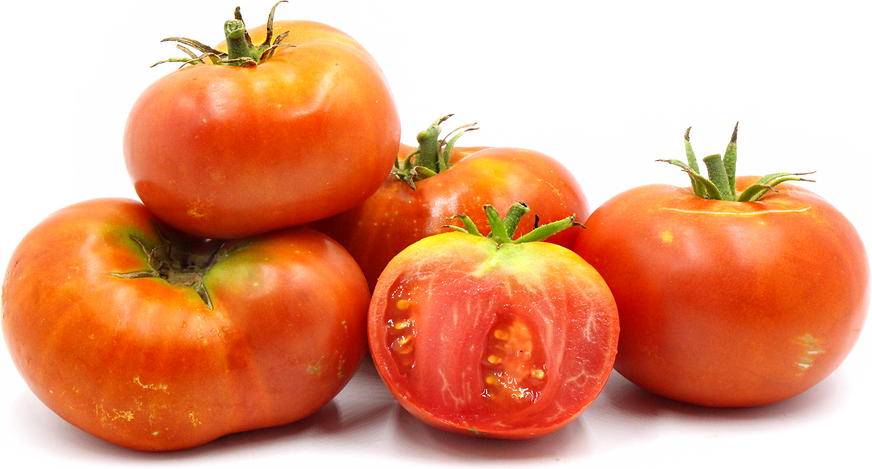


Jersey Boy Tomatoes
Estimated Inventory, lb : 0
Description/Taste
Jersey Boy tomatoes are a large, beefsteak variety that weighs between 225 and 425 grams. They have a flattened shape that ranges in appearance from mostly round to pumpkin-like, with the sides bulging above the area where the stem attaches. Jersey Boys have shiny, bright red skin that may have barely visible lines running from the bottom to the top of the tomatoes. Their skin is soft, firm, and resilient, protecting the fruits’ succulent flesh. The red flesh is meaty and dense, with small gel pockets that contain tiny, pale seeds. Jersey Boy tomatoes have a rich and balanced sweet-sour flavor.
Seasons/Availability
Jersey Boy tomatoes are available from mid to late summer.
Current Facts
Jersey Boy tomatoes are botanically classified as Solanum lycopersicum and belong to the Solanaceae, or nightshade, family that also includes eggplants and potatoes. Jersey Boy tomatoes are considered an Heirloom Marriage™ tomatoes because they are a hybrid of two heirloom varieties, Brandywine and Rugter tomatoes. Brandywine is a variety that was developed by Johnson and Stokes in the late 1800s, known for the sweet and sour taste that Jersey Boy tomatoes also exhibit. Rutger tomatoes are a variety developed at Rutgers University in the 1930s known for its robust shape and shiny red hue, qualities passed on to the Jersey Boy. Other Heirloom Marriage™ varieties include Yellow Pear, San Marzano, Black Krim, and Genuwine tomatoes. Jersey Boys are considered slicing tomatoes, primarily valued for their culinary attributes.
Nutritional Value
Jersey Boy tomatoes are rich in vitamin C, supporting immune health, collagen production, and preventing cell damage. They are a good source of vitamin A, a nutrient essential for eye, skin, and reproductive health as well as protection against infection and oxidative stress. Jersey Boy tomatoes contain beneficial B vitamins that encourage energy production, nerve function, red blood cell formation, brain function, digestion, and hormone and mood regulation. They are a good source of minerals such as calcium and iron, which are essential for bone health and oxygen transport in the blood, respectively. These tomatoes also contain phosphorus, sulfur, and potassium, which play key roles in bone health, detoxification, and maintaining proper fluid balance in the body.
Applications
Jersey Boy tomatoes can be eaten fresh, sautéed, grilled, baked, stewed, canned, or dried. When sliced, this variety pairs well on sandwiches, salads, burgers, pizzas, and lasagnas. Jersey Boy tomatoes can be chopped and added to hummus, cheese dips, gazpacho, tomato sauces, chutneys, and succotash. They pair well with meaty entrees like roasted chicken, meatballs, mussels, salmon, shrimp, and kebabs. These tomatoes may be incorporated into casseroles, pastas, omelets, soups, tarts, and pot pies. Jersey Boy tomatoes are complemented by the flavors of mozzarella, burrata, and feta cheese, avocados, cucumbers, basil, pesto, olive oil, balsamic vinegar, croutons, shallots, bell peppers, corn, lima beans, garlic, pimiento peppers, mashed potatoes, and white wine sauce. Store Jersey Boy tomatoes at room temperature until ripe, after which refrigeration can slow the process of decay.
Ethnic/Cultural Info
One of the parent varieties of the Jersey Boy tomato is the Ruger tomato, an American heirloom developed at Rutgers State University in New Brunswick, New Jersey. It was here that the Campbell's Soup Company launched a breeding program that would go on to create other notable varieties like the J.T.D. and Garden State tomato. Rutgers tomatoes were a notable variety because at one point, 72 percent of growers in the United States would produce this variety and it became used in Hunt’s and Heinz products. This variety's popularity declined during the 1950s and '60s due to technological advancements and a shift toward hybrid farming. In 2010, Rutgers University launched the Jersey Tomato Project to revive the Rutgers variety, eventually leading to the development of the Jersey Boy variety.
Geography/History
Jersey Boy tomatoes were initially developed at Rutgers State University in New Brunswick, New Jersey. They were hybridized by Burpee Seed Company and commercially released in 2015. They require at least 6 hours of direct sunlight in order to grow and thrive in warm, temperate climates or greenhouse environments. As a hybrid breed, Jersey Boy tomatoes are not found in the wild but may be cultivated commercially or in gardens. Breeds like the Jersey Boy and other hybrids developed by Rutgers University have gained commercial appeal because they are Heirloom Marriage™ varieties. This means they inherit the desirable characteristics of their parent tomatoes, resulting in fruit with high quality, improved disease resistance, and fewer blemishes. Despite their resilient nature, Jersey Boy tomatoes are a niche variety that may be primarily sourced from farmers' markets in New Jersey and other areas of the Northeastern United States or purchased from seeds to grow in home gardens.
Recipe Ideas
Recipes that include Jersey Boy Tomatoes. One
| Stacy Ling |
|
The Best Bruschetta Tomatoes Recipe |
Podcast




